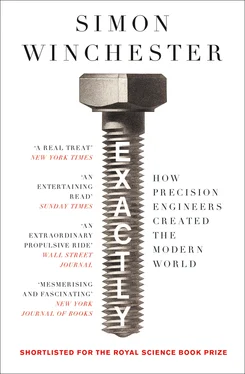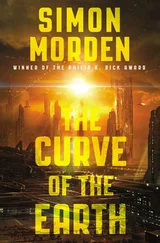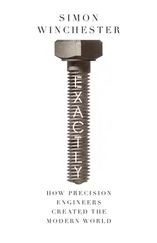It was not until 1951 that Derek Price, a young British student of the history and social impact of science, won permission to take a closer look at the Antikythera mechanism, and for the next two decades he subjected the shattered relic, with a total of now more than eighty additionally found bits and pieces as well as the three main fragments, to blizzards of X-rays and wafts of gamma radiation, probing secrets that had been hidden for two thousand years. Eventually, Price decided the work was much more complex and important than a mere astrolabe—it was in fact more likely to be the once-beating heart of a mysterious computing device of unimagined mechanical complexity, one that had evidently been made in the second century BC and was clearly a work of staggering genius.
Price’s work in the 1950s was limited by his technology’s inability properly to peer inside the device. All this changed with the invention twenty years later of computed tomography scanning, or CT, which led in 2006, more than a century after the sponge seekers made their first find, to the publication in Nature of a profoundly more detailed and sophisticated analysis.
The world-scattered team of specialist researchers who produced the Nature article concluded that what the Greek divers had pulled to the surface were the remains of a miniaturized and neatly boxed mechanical device, an analog computer, essentially, with dials and pointers and rudimentary instructions for how to use it. It was a device that “calculated and displayed celestial information, particularly cycles such as the phases of the moon and a luni-solar calendar.” Moreover, minuscule inscribed lettering in Corinthian Greek chased into the machine’s brass work—a total of 3,400 letters, all millimeter-size, have been found thus far—suggested that the gearwheels, once fully engaged with one another with the turning of a crank on the side of the box, could also predict the movement of the five other planets then known to the Ancient Greeks. *
Enthusiasts, a small but fervent corps of devotees of this extraordinary little instrument, have since built working models of the mechanism, in wood and brass and, in one instance, with its bronze innards expanded and exploded as in a 3-D checkers game, between layers of transparent Perspex. It was the numbers of teeth on the various wheels that offered the first clues as to how they might have been employed by the machine’s makers. The fact that there were 223 teeth on the largest of the gearwheels, for example, provided a eureka moment for the investigators, who remembered that Babylonian astronomers, who were the most astonishingly able watchers of the skies, had calculated that lunar eclipses were usually separated by 223 full moons. Use of this particular wheel, then, would have enabled the user to predict the timing of eclipses of the moon (just as other wheels and combinations of wheels would have turned pointers on dials to display phases and planetary perturbations) and the dates, more trivially, of upcoming public sporting events, most notably the ancient Olympic Games.
Modern investigators have concluded that the device was very well made, “with some parts constructed to accuracies of a few tenths of a millimeter.” By that measure alone, it would seem that the Antikythera mechanism can lay claim to being a most precise instrument—and, crucially for this introduction to the story, maybe the first precision instrument ever made.
Except that there is an inherent flaw in this claim. The device, as model-tested by the legions of fascinated modern analysts, turns out to be woefully, shamefully, uselessly inaccurate. One of the pointers, which supposedly indicates the position of Mars, is on many occasions thirty-eight degrees out of true. Alexander Jones, the New York University antiquities professor who has perhaps written most extensively about the Antikythera mechanism, speaks of its sophistication as being that only “of a young and rapidly developing craft tradition,” and of “questionable design choices” by its makers, who, in summary, produced a device that was “a remarkable creation, but not a miracle of perfection.”
There is one additional puzzling aspect of the mechanism that still intrigues historians of science to this day: while it was filled to bursting with what is self-evidently a complicated assemblage of clockwork, none of its assemblers apparently ever thought of using it as a clock .
Hindsight permits us to be puzzled, of course, and persuades us to want to reach back to the Greeks and shake them a little for ignoring what to us seems obvious. For time was already being measured in Ancient Greece with the help of all manner of other devices, most popularly with sundials, dripping water, hourglasses (as in egg timers), oil lamps with time-graduated fuel holders, and slow-burning candles with time graduations on the stick. And though the Greeks possessed (as we now know from the existence of the mechanism) the wherewithal to harness clockwork gears and make them into timekeepers, they never did so. The penny never dropped. It never dropped for the Greeks or, subsequently, for the Arabs or, even beforehand, for the much more venerable civilizations of the East. It would take many more centuries for mechanical clocks to be invented anywhere, but once they were, they would have precision as their most essential component.
Though the eventual function of the mechanical clock, brought into being by a variety of claimants during the fourteenth century, was to display the hours and minutes of the passing days, it remains one of the eccentricities of the period (from our current viewpoint, that is) that time itself first played in these mechanisms a somewhat subordinate role. In their earliest medieval incarnations, clockwork clocks, through their employment of complex Antikythera-style gear trains and florid and beautifully crafted decorations and dials, displayed astronomical information at least as an equal to the presentation of time. It was almost as though the passage of celestial bodies across the heavens was considered more significant than the restless ticking of the passage of moments, of that one-way arrow of time that Newton so famously called “duration.”
There was a reason for this. Nature’s offerings of dawn, midday, and dusk already provided the temporal framework—the mundane business of when it was time to rise and work, when came the time to rest, to mop the brow and take a drink, and when the time to take nourishment and prepare for sleep. The more finicky details of time (a man-made matter, after all), of whether it was 6:15 a.m. or ten minutes to midnight, were necessarily of lesser importance. The behavior of the heavenly bodies was ordained by gods, and therefore was a matter of spiritual significance. As such, it was far worthier of human consideration than our numerical constructions of hours and minutes, and was thus more amply deserving of flamboyant mechanical display.
Eventually, though, the reputation and standing of the hours and minutes themselves did manage to rise through the ranks, did come to dominate the usage of the clockwork mechanisms that became known, generically, as timekeepers. The Ancients may have looked upward to the skies to gather what time it was, but once machinery began to perform the same task, a vast range of devices took over the duty, and has done so ever since.
Monasteries were the first to employ timekeepers, the monks having a need to awaken and observe in some detail the canonical hours, from Matins to Compline by way of Terce, None, and Vespers. And as various other professions and callings started to appear in society (shopkeepers, clerks, men of affairs bent on holding meetings, schoolteachers due to instruct to a rigid schedule, workers on shifts), the need for a more measured knowledge of numerical time pressed ever more firmly. Toilers in the fields could always see or hear the hour on the distant church clock, but city dwellers late for a meeting needed to know how many minutes remained until the “appointed hour” (a phrase that gained currency only in the sixteenth century, by which time public mechanical clocks were widely on display).
Читать дальше












